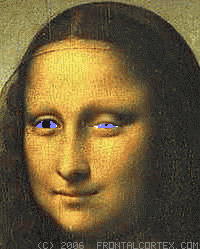Wallenberg Syndrome 1
Topic: Behavior
Created on Sunday, September 17 2006 by jdmiles
Last modified on Sunday, November 16 2008.

A famous elderly, retired model presents to the E.R. She had no neurologic defecits prior to this morning, when she awoke to several new symptoms, the most concerning to her of which are changes in the way her face looks, as shown in the image above.
She has smoked 3 packs of cigarettes per day for the past 65 years. She is overweight, has sleep apnea, and a recent LDL cholesterol level was 326 mg/dL. She has diabetes mellitus, and a recent hemoglobin A1C was 21. She has a history of poorly controlled hypertension. She is noncompliant with the medications prescribed to her for these conditions.
History and physical exam reveal new onset of decreased elevation of the palate on the left, vertigo, loss of pain and temperature sensation in the left face, loss of gustation, dysphagia, nystagmus, oscillopsia, anhidrosis in the left face, diminished gag reflex, loss of pain and temperature sensation in the right side of the body, decreased motion of the vocal cord on the left, paresthesias on the left side of the face, ataxia on the left, and lateropulsion to the left.
Of the following choices, which ONE other finding would you MOST expect to see in this patient?
This question was created on September 17, 2006 by jdmiles.
This question was last modified on November 16, 2008.
ANSWERS AND EXPLANATIONS
A) diplegia
This answer is incorrect.
Diplegia is not a component of the lateral medullary (Wallenberg) syndrome, and would not be expected from a lesion of the lateral medulla. (
See References)
|
 |  |  | 
|  |  |
| Please log in if you want to rate questions. |
B) resting tremor
This answer is incorrect.
Resting tremor is not a component of the lateral medullary (Wallenberg) syndrome, and would not be expected from a lesion of the lateral medulla. (
See References)
|
 |  |  | 
|  |  |
| Please log in if you want to rate questions. |
C) locked-in state
This answer is incorrect.
Locked-in state is not a component of the lateral medullary (Wallenberg) syndrome, and would not be expected from a lesion of the lateral medulla. (
See References)
|
 |  |  | 
|  |  |
| Please log in if you want to rate questions. |
D) vertical diplopia
This answer is correct.
This patient presents with history and physical findings consistent with a stroke in the lateral medulla (Wallenberg syndrome). Her findings are consistent with infarction on the left side of the medulla. A stroke in this location will cause damage to the vestibular nuclei, spinothalamic tract, descending sympathetic fibers, descending fibers of cranial nerves IX and X, and cerebellar tracts including the inferior cerebellar peduncle.
Damage to these structures produces a predictable constellation of symptoms, including nystagmus, vertigo, oscillopsia, nausea and vomiting, loss of pain and temperature in the contralateral half of the body, loss of pain and temperature sensation in the ipsilateral face, an ipsilateral Horner's syndrome (as shown in the image), hoarseness and dysphagia, ataxia, and ipsilateral lateropulsion.
You could expect to see vertical diplopia in this patient. (
See References)
|
 |  |  | 
|  |  |
| Please log in if you want to rate questions. |
E) ataxia on the right
This answer is incorrect.
Ataxia on the right would be seen in a right lateral medullary infarct, but not in a left lateral medullary infarct, which this patient has. (
See References)
|
 |  |  | 
|  |  |
| Please log in if you want to rate questions. |
References:
| 1. Zaidat, O.O., and Lerner, A.J. (2002). The Little Black Book of Neurology, 4th Edition. Mosby, St. Louis. (ISBN:0323014151) | Advertising:
|
| 2. Victor, M., and Ropper, A.H. (2001). Adams and Victor's Principles of Neurology, 7th Edition. McGraw-Hill, New York. (ISBN:0070674973) | Advertising:
|
|
 |  |  | 
|  |  |
| Please log in if you want to rate questions. |
FrontalCortex.com -- Neurology Review Questions -- Neurology Boards -- Board Review -- Residency Inservice Training Exam -- RITE Exam Review
behavior
Wallenberg Syndrome 1
Question ID: 69171
Question written by J. Douglas Miles, (C) 2006-2009, all rights reserved.
Created: 09/17/2006
Modified: 11/16/2008
Estimated Permutations: 0
























